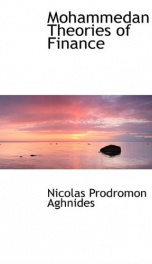mohammedan theories of finance

Purchase of this book includes free trial access to www.million-books.com where you can read more than a million books for free. This is an OCR edition with typos. Excerpt from book: there is a short-coming in the person of the transmitter, namely: (i) when he is " unknown " (mastur), i. e., when it is not known whether he is just or impious, although the first three generations are an exception to this rule; (2) when he is impious (fasiq) ; (3) when he has not attained the age of, or is not endowed with, complete understanding, as in the case of minors, the weak-minded (ma'tih), the careless (muggaffal), and heretics (sahib al haiva).1 SECTION III Qualifications Regarding the Transmitter as Such The transmitter (al-rawi) is of two kinds, the " well- known " (al-ma'rif) and the "unknown" (al-majhul). The " well-known ''is one known to have transmitted many hadlths, whereas the " unknown " is one who is not known to have transmitted more than one or two hadlths. (i) The " well-known " transmitter. He is of two kinds: the one who is also a faqlh, besides being a transmitter, and the other who is only a transmitter. (a) The well-known transmitters who are also faqlhs. As such are considered the first four Califs. 'Abdallah Ibn Mas'ud, 'Abdallah Ibn 'Abbas, Ibn 'Omar. Zayd, Mu'adh, Abu Musa al-Ash'ari, 'Aishah, and others. The hadlths reported by these are accepted whether or not in accordance with qiyas. (b) The " well-known " transmitters who are not faqlhs. These are those who like Abu Hurayrah are reputed for their justice and careful record-taking. The hadlths reported by these are accepted if in accordance with qiyas. In the contrary case they are abandoned, because these transmitters, not being faqlhs, may have taken a wrong record. 1 Tawf)ib, p. 372. wdib, p. 362; Pazdawi, pp. 758 et seq. If however, their reports are in accordance with one qiyas and at variance with another, they are not abandoned. (2) The "unknown" transmitter... --This text refers to the Paperback edition.
Info about the book
Author:
Series:
Unknown
ASIN:
B008C1VM6K
Rating:
3.5/5 (4)Your rating:
0/5
Languge:
English
Users who have this book
Users who want this book
What readers are saying
What do you think? Write your own comment on this book!
write a commentif you like mohammedan theories of finance try:
Other books by this author
Do you want to exchange books? It’s EASY!
Get registered and find other users who want to give their favourite books to good hands!

